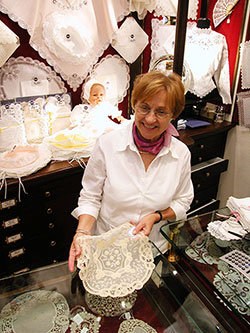Top tips for smart shopping in Europe
This item appears on page 63 of the April 2010 issue.
Shopping in Europe can be fun, but not if you let it overwhelm your trip. I like to shop smart, spending my time — and money — efficiently. Based on three decades of travel, here are my top tips for shopping in Europe.
Shop in countries where your dollar goes further. Shop in Turkey, Morocco, Portugal, Spain, Greece and Eastern Europe, where the dollar is relatively strong. For the price of a doily in Britain, you can get a lace tablecloth in Spain.
Shop at flea markets. The most colorful shopping in Europe is at its open-air secondhand markets. Among the best are Amsterdam’s Waterlooplein, London’s Portobello Market, Madrid’s El Rastro and Paris’ Puces St. Ouen. Flea markets anywhere have “soft” prices; bargain like mad. Note: pickpockets love flea markets; wear your money belt and watch your day bag.
Check out large department stores. These often have a souvenir section with standard local knickknacks and postcards at prices way below those of the cute little tourist shops. While the stores seem daunting at first, they generally work like ours. Most are accustomed to wide-eyed foreign shoppers and have English-speaking staff.
In Paris, visit Galeries Lafayette or Printemps. Harrods is London’s most famous and touristy department store, but locals prefer Liberty on Regents Street. In Italy, an upscale department chain is La Rinascente, and in Spain, El Corte Ingles is good. Berlin’s mammoth Kaufhaus des Westens (KaDeWe) has a staff of 2,100 to help you sort through its vast selection of 380,000 items.
Europe-wide chains can offer good value, especially for designer-inspired clothing. H&M (www.hm.com) and C&A (www.c-and-a.com) have stylish, affordable selections.
Comparison-shop… at home. Often you can pick up a very similar item of better quality for a cheaper price at home. Do some research if you are looking for a high-end item. Before heading off to buy a Turkish carpet in Istanbul, learn the going rate, types of material and signs of quality — if only to avoid advertising your inexperience.
Unless you’re a real romantic, the thrill of where you bought something fades long before the item’s usefulness does. Even thoughtful shoppers go overboard. I have several large boxes in my attic labeled “great souvenirs.”
Try to restrict your shopping to a stipulated time. Most people have an idea of what they want to buy in each country. Set aside one day to shop in each country, and stick to it. This way, you avoid drifting through your trip thinking only of souvenirs.
If you’re a fanatic about packing light, wait until the end of your trip to shop, then go hog-wild in the last country you visit and fly home heavy. One summer I had a 16-pound backpack and nothing more until the last week of my trip when, in Spain and Morocco, I managed to accumulate two medieval chairs, two sets of bongos, swords, a mace and a camelhair coat — most of which are now (see previous point) in boxes in my attic.
Choose good souvenirs. My favorites are books; these are a great value all over Europe, with many editions impossible to find in the United States. I look for local crafts, such as hand-knit sweaters in Portugal or Ireland, glass in Sweden, painted beehive panels in Slovenia or lace in Belgium. I also like strange stuffed animals (at flea markets), CDs of music I heard live, posters (one sturdy tube stores eight to 10 posters safely), clothing, and photographs I’ve taken.
Know the rules for US Customs. You’re allowed to take home $800 worth of items per person duty-free. If you’re at least 21, you can also bring back a liter of alcohol duty-free, but you’ll need to pack it (carefully) in your checked luggage, due to restrictions on liquids in carry-ons.
If I fall in love with a variety of wine, I don’t bother lugging back a bottle. I just write down the name and look for it back home.
To check Customs rules and duty rates, visit www.cbp.gov. (Click “Travel,” then “Know Before You Go.”)
Remember that window-shopping is free. Shopping is an important part of most people’s trips, but, all too often, slick marketing and romantic displays can succeed in shifting the entire focus of your vacation toward things in the tourist shops. I’ve seen half the members of a guided tour of the British Halls of Parliament skip out to survey a display of plastic “bobby” hats. Stay in control.
Europe is a cultural carnival and, time after time, you’ll find that its best acts are free and the greatest seats are the cheap ones. Have fun, shop smart and remember that your most prized souvenirs are your memories.

